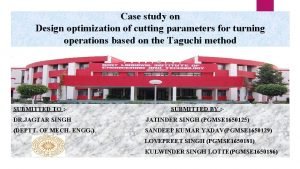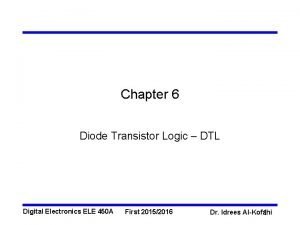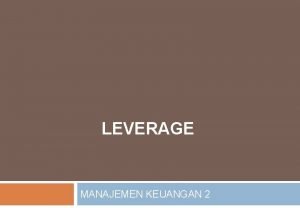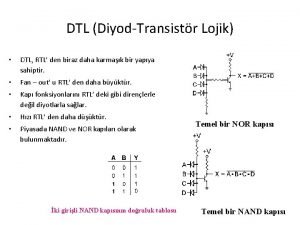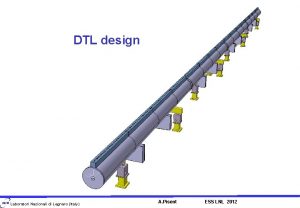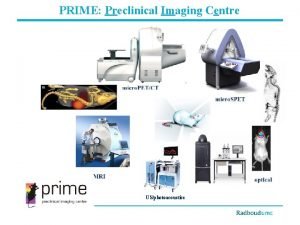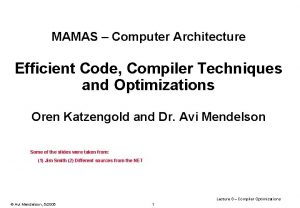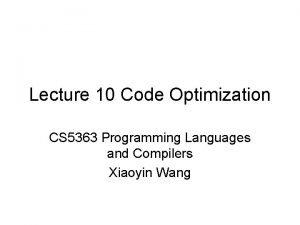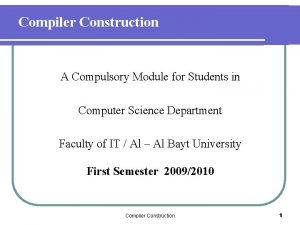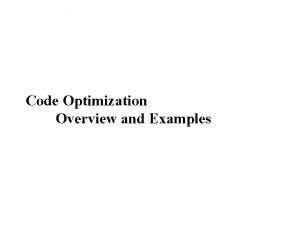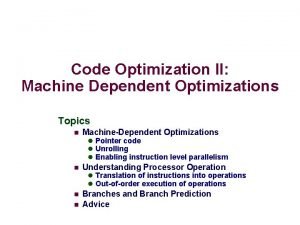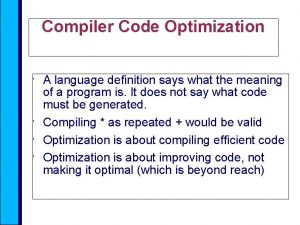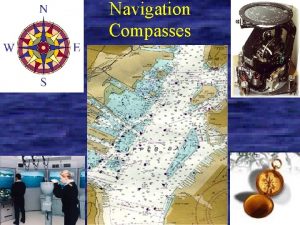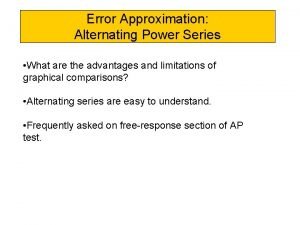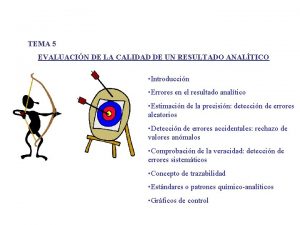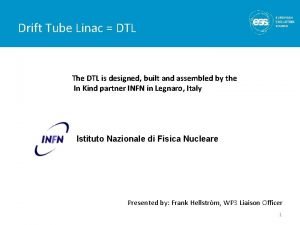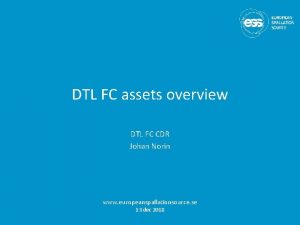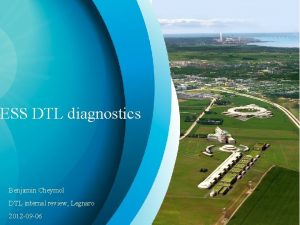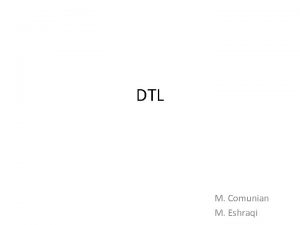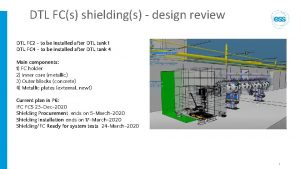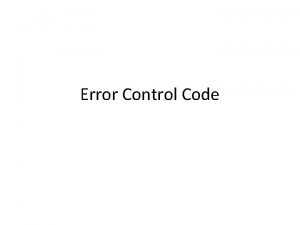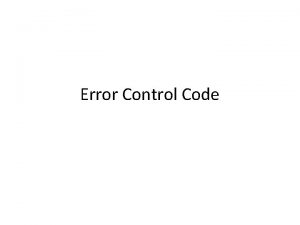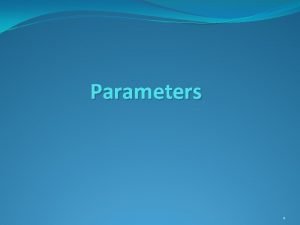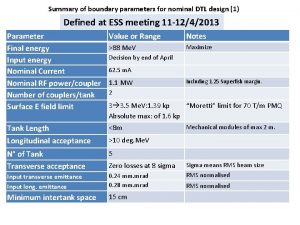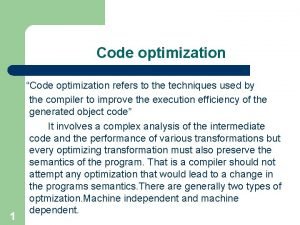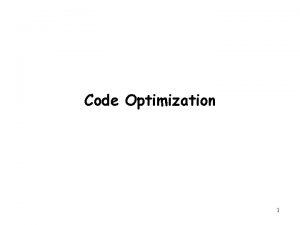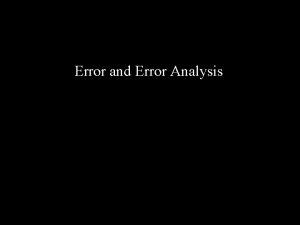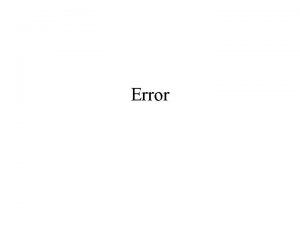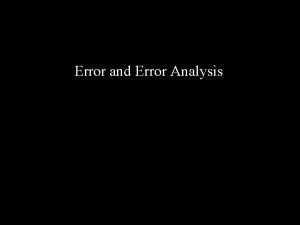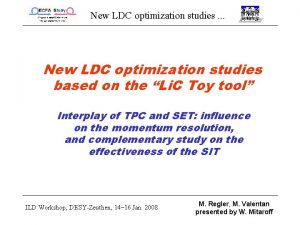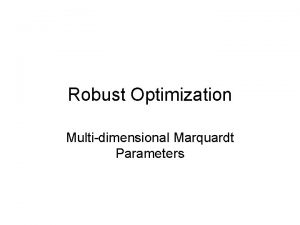Code parameters optimization DTL Tank 1 error studies























- Slides: 23

Code parameters optimization & DTL Tank 1 error studies Maud Baylac, Emmanuel Froidefond Presented by JM De Conto LPSC-Grenoble HIPPI yearly meeting, Oxford, September, 2005

Overview • Goal, recall TW inputs • Optimization of code parameters • Nb runs • Nb calculations per βλ • Nb particles • Space charge routine: • 2 d vs 3 d • Mesh size • Error study • Individual sensitivity: longitudinal & transverse • Effect of input distribution • Global errors, loss • Set of tolerances

Goal • For us: learn how to use Trace. Win • Study sensitivity of DTL to quadrupole and field errors • Determine set of tolerances for tank 1 for quadrupole alignment quadrupole gradient klystron field amplitude and phase gap field amplitude

Trace. Win inputs • • • Several inputs: evolutive DTL design Input distribution: mainly type -32 (Gaussian) file Worse case scenario & Same for all studies 2 types of simulations: Sensitivity: one type of error at a time (e. g. : δx ) Global error effect: all types of errors at once Each error generated randomly & uniformly in [–max; +max] For all cases, transport to the end of the DTL

Number of runs • Study convergence with nb of runs DTL 2004 1000 runs

Nb space charge calculations per βλ Inactive on DTL cells Default for DTL cells: • was 1 space charge calc. per cell (ie: 20 calc. per betatron oscil. ) • modified to up to 3 calc. per cell (depending on cell length)

Number of particles • Most simulations use 50 kparticles (1000 runs) – Fast calculation – Minimal loss: 20 ppm • A few global error runs use 106 particles (5000 runs) – 250 to 400 CPU hours – Minimal loss: 1 ppm

Space charge routines

Space charge routines comparison Example: 1 run with 1. 5 mm x displacement of the 1 st quad with PICNIR & PICNIC DTL 2004 PICNIR (2 d) PICNIC (3 d) 2 d vs 3 d disagreement can be very large Not understood PICNIR (2 d) PICNIC (3 d)

Space charge routines disagreement • • • large for large emittance growth if X ≠ Y (our case) increases with beam current much more pronounced for FFDD vs FODO for transverse phenomenon Agreement for longitudinal errors (unexplained) Þ Use 3 d PICNIC with optimized mesh size

Optimization of mesh size Gausup Mismatch beam (40% in x/y/z) at DTL input to generate large emittance growth 3 d (PICNIC) 2 d (PICNIR)

7 x 7 mesh size through DTL Gausup Matched beam through DTL: validation of mesh size 3 d (PICNIC) 2 d (PICNIR)

DTL with all errors 7 x 7 mesh statistically compatible with high resolution mesh & keeps calculation time reasonable

Sensitivities to longitudinal errors DTL 2005 Error type Longitudinal errors Max error amplitude (mm or deg) Eklys/Eklys = ± 1% φklys = ± 1 deg Egap/Egap = ± 1% < εx / εx > ± rms (%) < εy / εy > ± rms (%) < εz / εz > ± rms (%) 0. 0 ± 0. 5 0. 0 ± 0. 6 0. 5 ± 0. 7 Gaussian distribution, 50 kpart, 1000 runs Very little effect for all 3 longitudinal errors combined

Sensitivities to transverse errors Error type Max error amplitude (mm or deg) Displ x ± 0. 1 mm DTL 2005 < εx / εx > ± rms (%) proba (%) 1. 0 ± 0. 8 <1% : 60 <5% : 100 Rota x (pitch) Rota z (roll) ± 0. 5 deg ± 0. 2 deg ± 0. 5% < εz / εz > ± rms (%) proba (%) 0. 1 ± 0. 1 <1% : 100 <5% : 100 0. 7 ± 0. 5 <1% : 76 <5% : 100 0. 01 ± 0. 01 1 E-3± 3 E-3 0. 01 ± 0. 01 <1% : 100 <5% : 100 0. 8 ± 0. 6 <1% : 76 <5% : 100 G/G < εy / εy > ± rms (%) proba (%) 0. 1 ± 0. 2 <1% : 100 <5% : 100 0. 7 ± 0. 6 0. 02 ± 0. 02 <1% : 77 <5% : 100 0. 1 ± 0. 3 <1% : 100 <5% : 100 0. 02 ± 0. 07 <1% : 100 <5% : 100 Gaussian distribution, 50 kpart, 1000 runs Some emittance growth No loss Energy jitter: a few 10 -4 Phase jitter: a few 10 -4

Longitudinal rotation (roll) DTL 2005 • Emittance growth similar in x & y (coupling) • Emittance growth quadratic with roll angle Confirmed by theoretical calculations • No longitudinal emittance growth

Effect of input distribution Design & Distribution 2005 Gaussian < εx / εx > ± rms (%) proba (%) < εy / εy > ± rms (%) proba (%) 2. 0 ± 1. 0 1. 9 ± 1. 0 <1% : 13 <5% : 99 1. 5 ± 1. 0 2005 KV <1% : 35 <5% : 100 <1% : 15 <5% : 99 1. 5 ± 1. 0 <1% : 37 <5% : 100 DTL 2005 < εz / εz > ± rms (%) proba (%) RMS x (mm) & RMS x’ (mrad) RMS y (mm) & RMS y’ (mrad) 0. 9 & 1. 0 1. 1 & 0. 8 0. 9 & 1. 1 & 0. 9 1. 5 ± 0. 8 <1% : 28 <5% : 100 1. 1 ± 0. 7 <1% : 57 <5% : 100 Gaussian distribution, 50 kpart, 1000 runs Simple shift (30 -50%), no broadening Losses Loss < 2 E-5

Effect of input distribution: transverse errors DTL 2005

Global effect with high statistics: transverse & longitudinal errors 106 particles, 4291 runs, Gaussian input, 250 to 400 CPU hours for each run Design & errors < εx / εx > ± rms (%) proba (%) 2. 0 ± 1. 0 2005 Trans. + longi. < εy / εy > ± rms (%) proba (%) 2. 0 ± 1. 0 < εz / εz > ± rms (%) proba (%) E ± rms (ke. V) φ ± rms (deg) 56. 6 ± 0. 4 3. 11 ± 0. 01 Loss < 1 E-6 56. 5 ± 2. 6 3. 13 ± 0. 15 Loss < 1 E-6 1. 5 ± 0. 8 <1% : 13. 8 <5% : 98. 7 <1% : 14. 2 <5% : 98. 6 <1% : 26. 5 <5% : 99. 9 2. 0 ± 1. 2 1. 9 ± 1. 1 <1% : 20. 4 <5% : 98. 5 <1% : 20. 3 <5% : 98. 1 <1% : 20. 1 <5% : 99. 1 Losses Some broadening in longitudinal direction δx/y= ± 0. 1 mm Φx/y = ± 0. 5 deg Φz = ± 0. 2 deg G/G = ± 0. 5% and φ/φ=± 1 deg E/Eklystron=± 1% E/Egap=± 1%

Main trends of quadrupole alignment • Transverse displacement (symmetric x/y ) transverse & longitudinal emit. growth 2005 design: ~ 1% for ± 0. 1 mm • Transverse rotation (pitch & yaw): no effect • Longitudinal rotation (roll): transverse emit. growth 2005 design: ~ 0. 8% for ± 0. 2 deg • Emittance growth with 2005 design vs 2004 design: slightly worse with errors on all tanks • Individual sensitivities roughly add up

DTL tank 1 tolerances Tolerances agreed upon by DTL task force: • quadrupoles: longitudinal displacements: δx, y = ± 0. 1 mm longitudinal rotations: Φ x, y = ± 0. 5 deg transverse rotations: Φ z = ± 0. 2 deg gradient: G/G = ± 0. 5% • accelerating field: klystron field amplitude: Eklys/Eklys = ± 1% klystron field phase: φklys = ± 1 deg gap field amplitude: Egap/Egap = ± 1%

Conclusions • Sensitive parameters: transverse displacement & roll • Little effect due to longitudinal errors (longitudinal shift cannot be tested with TW) • With present tolerance budget, beam quality sees little degradation through DTL: Emittance growth x, y and z < 5% in 98% of runs Loss < 10 -6 RMS width in x and y < 1. 2 mm RMS width in x’ and y’ < 1. 1 mrad • Multipolar component contribution: waiting for TW debug • Code benchmarking to validate results

Acknowledgements • Didier URIOT (CEA/DSM) for discussions and multiple debugs • Nicolas PICHOFF (CEA/DAM) for discussions regarding space charge calculations • Edgar Sargsyan, Alessandra Lombardi and Frank Gerigk (CERN) for inputs and discussions
 Optimization of cylindrical grinding process parameters
Optimization of cylindrical grinding process parameters Busceral
Busceral Deferred tax asset journal entry
Deferred tax asset journal entry Fas 109 and fin 48
Fas 109 and fin 48 Dtl inverter
Dtl inverter Operating leverage adalah
Operating leverage adalah Dtl nand
Dtl nand Dtl design
Dtl design Dtl prime
Dtl prime Paradigm shift from women studies to gender studies
Paradigm shift from women studies to gender studies Code optimization techniques
Code optimization techniques Peephole optimization is machine dependent
Peephole optimization is machine dependent Machine independent code optimization
Machine independent code optimization Code optimization techniques
Code optimization techniques Machine dependent code optimization
Machine dependent code optimization Code optimization definition
Code optimization definition Type 1 error vs type 2 error example
Type 1 error vs type 2 error example Type 1 error vs type 2 error example
Type 1 error vs type 2 error example Cdmvt rule
Cdmvt rule Hypothesis in research
Hypothesis in research Random and systematic errors examples
Random and systematic errors examples Lagrange error bound vs alternating series error bound
Lagrange error bound vs alternating series error bound Error sistematico y error aleatorio
Error sistematico y error aleatorio Error
Error
